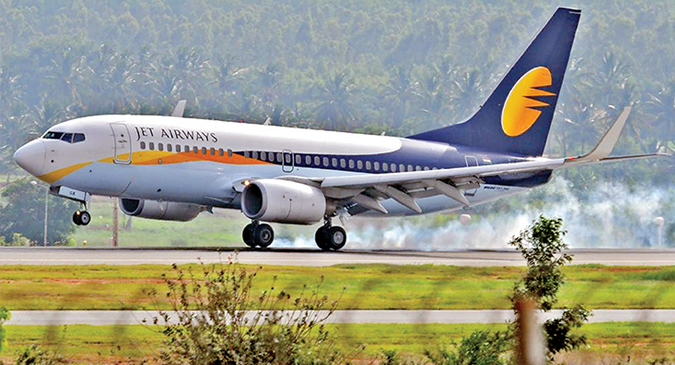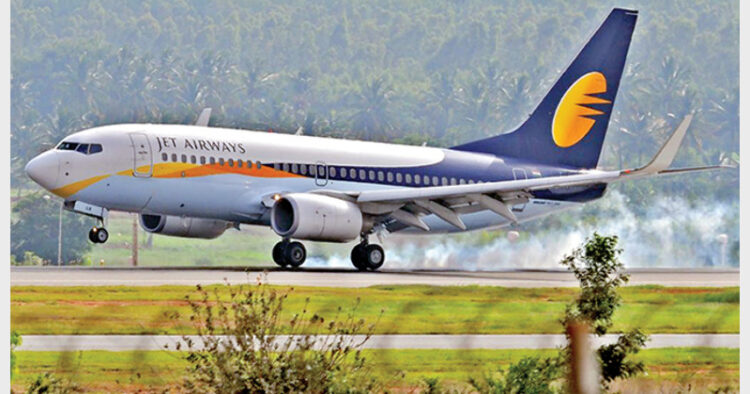The fall of Jet Airways would not only make more than 20,000 employees jobless but also raises question on the sustainability of already struggling aviation sector in India
Rajeev Upadhyaya
The way Jet Airways is down, it confirms that history repeats itself. However, it is temporarily down but there is a rare possibility that it would be back in the air again. It seems Jet Airways would have the same fate as of Kingfisher’s. In the similar fashion, Kingfisher was temporarily brought down by Directorate General of Civil Aviation in 2012 and it could never fly back. And the reasons were the very same; unsustainable huge amount of debt in the books of account.

Jet Airways employees staging a protest over delay in their salaries at T-3 of IGI Airport in New Delhi on April 13, 2019
Jet Airways is debt-ridden and unable to even service the debt. Being a full fledged airline, it has very high operational costs. At present, there are no pilots to fly its planes as it has failed even to pay salary to its staff for long. Apart from these, lenders have already declined to offer emergency fund even after giving verbal assurance of providing with Rs 1200 crore to Jet Airways. And there are rumours in the air that employees are planning to go to court to recover their due. These circumstances make it even more difficult for Jet Airways to hit back in the air.
After many incidents of defaults on meeting liabilities on many occasions, the bankruptcy of Jet Airways looks to be an utmost possibility. If the bids of May 10, 2019 are not accepted by lenders, they would move to National Company Law Tribunal (NCLT) for insolvency proceedings under Insolvency and Bankruptcy Code (IBC) 2016. And coming back from that point would be almost impossible for Jet Airways.

The fall of Jet Airways would not only make more than 20,000 employees jobless but also raises question on the sustainability of already struggling aviation sector in India. It might have long term consequences for the Indian aviation industry which is already turning through a transition period as it is in dilemma and not sure which model (low cost or full fledge) of operation it should opt for. In recent times the profits of a few profitable carriers are continuously falling and most are making huge losses. This clearly indicates that on overall aviation sector is not in good health. A careful look in the incidents over a few decades in the industry clearly indicate that the reasons for the problems in the aviation sector are not only limited to the operational strategies of these carriers but also the government’s policies on fuel pricing and maintenance charges imposed by the Airport Authority of India. Besides these, there are many other questions which have been unaddressed for long ranging from capital restructuring to corporate governance to roles and responsibilities of independent directors.
The issue of Jet Airways is not just about a company or the aviation sector, but it is a specific issue of regulatory failure to ensure good corporate governance practices and this trend is not just limited to the aviation sector. It plagues all over and is continuing since long in most of the default cases. Moreover, the statuary committees seem to be not working efficiently. Independent directors failed to ring a bell. Ministry of Corporate Affairs and Ministry of Aviation along with AAI could not check whether its policies are working well for the industry or not. This needs to be addressed.
- Quick TakeSpicejet absorbed 500 employees of Jet Airways including 100 pilots and Air India hired around 150 employees
- 23,000 Jet employees have not been paid their salaries for several months now
- Stepping down of ex-chairman Naresh Goyal due to pressure from the lenders
- Lenders have denied extending emergency funds for its survival; Jet has a debt of more than 8,500 crore
- Lenders have put the Jet Airways stakes for sale and even extended the existing deadline to attract potential bidders but failed to do so
Besides these, there is a need to check the way financing is done in the industry. The capital restructuring has been a common practice in banking and financial industry to deal with NPAs. Also, there is a practice of converting debt into equity. Specifically, these two practices seem to be the cause of the problem of big-ticket default in most of the cases. It has been witnessed that capital restructuring is done a number of times which eventually increases debt amount on the books of account of these distressed companies. This practice cleans the books of banks and financial institutions in the short term but in long term gravitates the problem as the unsustainable debt on books of the firms forces the firms to fail on servicing debt. In fact, this practice in most cases is like window dressing. The same happens with equity conversion. Banks and financial institutions convert debt into equity of distressed firms. This practice also cleans the books of banks and distressed firms. As a result the liability of these firms fall in the short term but this does not provide a long term solution.
In both cases, the fall of distressed firms has huge costs for the economy and banking and financial institutions. And in the case of public sector banks, the costs have to be borne by the public exchequer. These two things particularly need to be addressed by the Ministry of Finance and Reserve Bank of India. There should be a clear mandate on capital restructuring and for that there is a need for a professional agency to do that either in the form of advisory or regulatory role under RBI. In the case of equity conversion, banking and financial institutions should be completely banned from such practices. For such activities, there should be some professional agencies which should be involved in this business than banks and financial institutions. This will transfer the risk from banking and financial institutions to specialised agencies which could deal with such risks. These two things on overall will bring down the risk in the economy as well and the incidents of default can be effectively brought down.














Comments